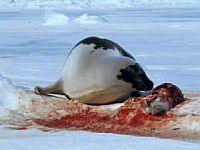 Hanging by the neck from a wire noose, water is poured down their throat through a hose until they drown. Many are skinned while still alive!
Hanging by the neck from a wire noose, water is poured down their throat through a hose until they drown. Many are skinned while still alive!
This is the ground reality of ‘fur advertisements’ which every now and then hit our television screens or could be seen adorning the magazines. But the sorry state of affairs is that no one realizes that numerous living creatures have sacrificed their life just for the sake of these stunning and ravishing garments.
Nearly, two million killings (of cats and dogs) are carried out in China alone annually, just for the heck of so called fashion, majority of populace are taking the notion of killing the innocent animals, lightly. Investigators documented 50,000 to 100,000 cat pelts stockpiled at animal by-product factories in China.
Little Animals, Big Suffering
Millions of fur-bearing animals including foxes, raccoons, minks, coyotes, bobcats, lynxes, opossums, nutria, beavers, muskrats, otters, and others are killed each year on fur farms by anal and vaginal electrocution and in the wild by drowning or trapping. Can you beat that?
Up to 8,000 animals are loaded onto each truck, with cages stacked on top of each other. Cages containing live animals are commonly tossed from the top of the trucks onto the ground 10 feet below, shattering the legs of the animals inside them.
During genital electrocution, the killer attaches an alligator clamp to the animal’s ear and another to her labia and flips a switch, or plugs the wire into the wall socket, sending a jolt of electricity through the animal’s skin down the length of their body. The poor creature jerks and then stiffens.
But, according to biologist Leslie Gerstenfeld-Press, although the electrical current stops the heart, it does not kill the animal: In many cases, the animal remains conscious.
If the situation will continue to grow like this, then time is not far when, these animals would become the next endangered species on this planet.
Nearly, 31 million animals are killed on fur ranches each year.
About twenty-six million are mink.
4.5 million Fox
250,000 Chinchillas
150,000 Sable
100,000 Fitch
100,000 Raccoon dogs
Fur industry, a bane for the animals:
Instead of lounging around the family home, some cats and dogs have been enhancing the outfits of high profile people in some countries.
If we look at the past decade, we’ll find that various species of animals were nearly at the verge of extinction, including the Juan Fernandez, Guadelupe and Antarctic fur seals and the sea otter. Fortunately these populations are recovering. However, now many spotted cat species are endangered because of the fur trade.
Even when species are protected, there will always be poachers willing to break the law for the big money someone will pay for a rare pelt. In April 1995 WSPA undercover investigators were offered illegal ocelot skins for sale in Brazil.
EU proposes to put ban on cats and dog fur
In order to avert the consequences, the European Parliament has supported a proposal which restricts the import of fur. Members of the European Parliament (MEP) have postulated that in majority of the cases, customers unintentionally procure it because the exporters tend to affix false labels to the products.
Labour MEP Arlene McCarthy asserted,
Many people are unwittingly deceived into buying garments made out of cat and dog fur due to mislabeling. This law will put an end to these deceptive practices.
There’s hardly any product left untouched, it is extensively used in coats, linings for boots and gloves, stuffed toys, and even homeopathic aids for arthritis.
Proposal of the ban would give weight-age to already existing similar prohibition in the EU member states and the United States, the foundations of which was laid down in 2003, in where more than half of the members signed a document backing the ban.
Yes, there’s a way out!
As has been said earlier, when synthetic fur is readily available in the market then there’s no point of slaughtering these poor creatures. It is expected that by barring these profanity, the authorities are moving in right direction. Also I’d like to add that culprits who are still carrying this horrible deed must be punished in such a manner that people might think twice before taking it as their profession.
But above all these things, people who are in the field of advertising and making garments, especially designers must speak out publically about the sensitized issue, it would then be instrumental in generating a strong message towards anti- fur campaigns.



